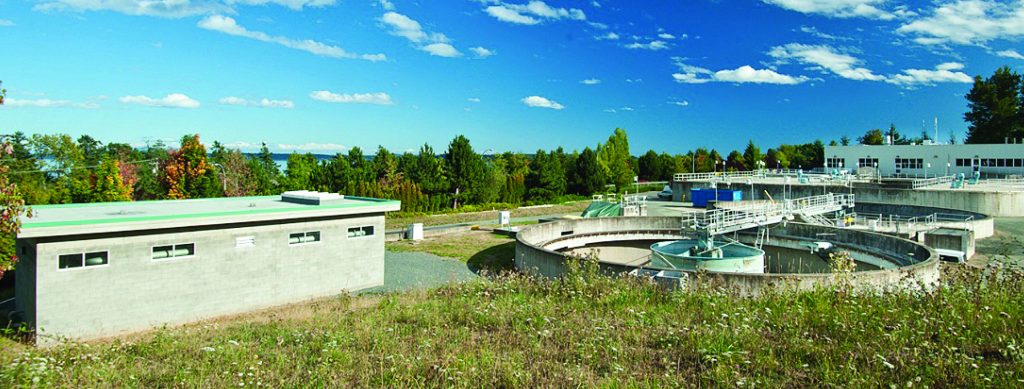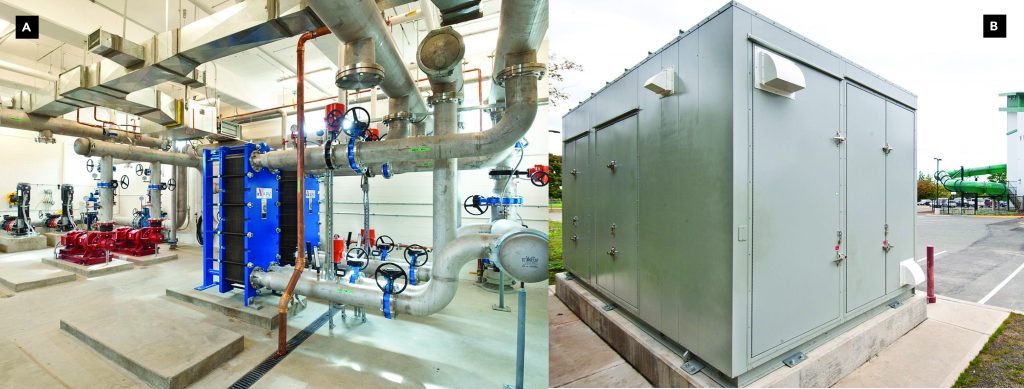Multistack Helps British Columbia Capital Region District Save Money and Energy!
Vancouver, British Columbia
Earns Canadian Sustainable Community Award

Multistack products are key components in the new Saanich Peninsula Thermal Energy Recovery System that is saving the British Columbia Capital Region District (CRD) significant annual operating costs and eliminating 377 tons of greenhouse gas emissions per year—equivalent to removing 79 passenger vehicles from the road.
The CRD was recently awarded the Federation of Canadian Municipalities Sustainable Community Award for this system. Saanich Peninsula is located southwest of Vancouver B.C., across the Strait of Georgia on Vancouver Island.
A team led by Opus DaytonKnight Consultants with DEC Engineering was selected for the design and construction of the Saanich Peninsula Thermal Energy Recovery System. The system captures thermal energy from wastewater effluent to provide supplemental hot water and space heating for the Panorama Recreation Centre. Treated waste water effluent is pumped to heat exchangers where heat energy is transferred to the District Energy System (DES). The DES loop delivers energy to the Multistack Dedicated Heat Recovery Chiller (DHRC) at the Panorama Recreation Centre
The Multistack chiller is comprised of three modules of 70 , 50 and 20 tons capacity to provide 44F chilled water to air handlers that supply conditioned air to the building, including production areas and office and laboratory space. Each module includes multiple compressors and refrigeration circuits for best efficiency, reliability and redundancy.
Tom Ren, Project Engineer for Alternative Energy at DEC Engineering, said, “We wanted to design a “mini-plant” solution that was unique and yet applicable across North America. Space in the mechanical room at the Panorama Recreation Centre was already very limited. We considered numerous ideas, eventually deciding to use a Haakon air handling unit enclosure that contains the Multistack DHRC chiller, pumps, controls and electrical load center. It’s very similar to a rooftop air conditioning unit except that it sits on the ground. It was important that it be packaged and secure to protect the components.”
Another advantage of the mini-plant enclosure is that because it is not a new building or building addition, DEC didn’t need to complete a complex building permit approval process.
The Multistack DHRC uses thermal energy in the DES loop to provide hot water at the necessary pool heating system temperatures for the Panorama Recreation Centre. Trane Northwest, the Multistack representative in British Columbia, provided two Model MS70X chiller modules installed in the Haakon outdoor enclosure along with pumps, piping and controls. Multistack DHRC units are available for many hydronic heating applications and produce hot water up to 180 degrees F while simultaneously producing chilled water for cooling systems. Using heat from the DES offsets natural gas used to heat water in the existing PRC boilers. This generates immediate savings because the reclaimed effluent energy is essentially free. In addition, greenhouse gas emissions are greatly reduced by replacing natural gas combustion with clean BC hydroelectricity. Multistck DHRC units are ideal for application in hospitals, data centers, and hotels that have a constant cooling load from computer rooms, labs, and storage areas while requiring heat for hot water, processing, and sterilization. With a DHRC system, building owners can save money and significantly reduce carbon footprint. DHRC units can generate hot water from 110-180°F and have proven to be three times more efficient than a gas boiler.
John Curran, Trane Northwest National Accounts Executive, said, “The mini-plant recovers heat energy from the district waste-water treatment plant and transfers that energy to the Recreation Center for the swimming pool and ice arena.”
The waste-water plant currently treats 9,000 cubic meters of waste water per day representing over 4MW of potential power with plans to increase that capacity in the future. Connected to the DES, each individual Multistack DHRC mini-plant delivers up to 12,000 kWh daily. ADI Austin & Denholm Industrial Sales Inc. completed the plumbing and pump installation while Trane Northwest installed the controls, managed the jobsite coordination and commissioned the chillers. Curran added, “This was a great team effort that allowed us to provide the customer with a completely packaged unit that simply required power and fluid connections.”
Tom Ren adds, “Another reason we decided to use the Multistack DHRC (Dedicated Heat Recovery Chiller) is that these units can produce the high water temperatures (up to 180 degrees F) required for the project—conventional chillers can’t produce those temps. We’ve used Multistack products on many other projects. Multistack is committed to helping their customers find solutions to their needs. They think outside the box to find a solution.”
The CRD was recently awarded the Federation of Canadian Municipalities Sustainable Community Award for this system. DEC Engineering’s “mini-plant” solution with the Multistack DHRC chiller is unique yet applicable across North America.
The Multistack control system allows the DHRC chiller to extract as much heat as possible from the wastewater system. Traditional heat recovery chillers will trip out with colder water and that has been a problem on other projects with other chillers that use controls less sophisticated than Multistack’s
Controls Critical
According to Tom Ren, the Multistack DHRC chiller controls were a critical aspect of the project. “The Multistack control system allows the DHRC chiller to extract as much heat as possible from the
wastewater system. Traditional heat recovery chillers will trip out with colder water and that has been a problem on other projects with other chillers that use controls less sophisticated than Multistack.”
The DES project was initiated in June, 2011, and had a total value of $3.3 million dollars. The Canadian Federal Gas Tax Agreements Innovations Fund provided $2.98 million in grant funding. Additional funds came from the Saanich Peninsula Wastewater System Sewer Debt Reserve Fund. Three more mini-plants are planned as the Saanich community continues to grow. The CRD plans to eventually connect to the DES not only the wastewater treatment plant offices, a school and the government greenhouse plant, but also the growing urban community.
The original Panorama Recreation Centre renovation and aquatic complex expansion was completed and opened in October, 2009. Construction started on March 10, 2008 and included removal of the original 1977 building, while retaining the pool and including it in the new space. Located in North Saanich only 25 minutes from it in the new space. Located in North Saanich only 25 minutes from Victoria, Panorama Recreation Centre provides a wide variety of recreational opportunities, including:
- A 25 meter salt-water purification swimming pool with six lanes, a multi -use leisure pool (including zero-depth entry, lazy river, tots’ area, two additional lanes, spray toys and benches with hot tub jets), sauna, steam room, swirl pool and additional multi-purpose rooms.
- The accessible waterslide tower includes an elevator allowing persons with mobility issues to enjoy southern Vancouver Island’s tallest and longest waterslide.
- Two skating arenas, which are bare for four months in the summer, for ice and dry floor activities.
- Weight room with cardio and strength equipment.
- Fitness courses available at the Panorama Recreation Centre include aerobics/fitness, fencing, yoga and others.
- Indoor and outdoor tennis courts.
- Racquetball and squash courts.
- Community recreation programs such as arts, music, dance, computers, cooking, language and sports.

A: Saanich Peninsula PRC mechanical room. B: Outdoor DHRC™ enclosure; DHRC module pictured right.
About Opus DaytonKnight Consultants Ltd.
Opus DaytonKnight Consultants Ltd. has over 45 years of service excellence, providing a wide range of clients with service in the areas of water, wastewater and environmental engineering. Opus DaytonKnight Consultants Ltd is a division of Opus International Consultants Ltd, a multi-disciplinary engineering consulting firm employing over 2,400 people worldwide working with clients to create sustainable communities through the development and management of world class infrastructure. Opus Dayton Knight provides innovative and sustainable engineering solutions and is focused on being a leading environmental consulting firm in Canada.
Opus DaytonKnight expertise includes sewage collection, treatment, disposal and reclaimed water reuse; water supply, treatment and distribution; storm water management, trenchless technologies, solid waste management, shoreline protection work, asset management, and security issues. Expertise is provided in sanitary and health engineering, hydraulics, hydrology, structural, electrical, mechanical, instrumentation, SCADA, and computer modeling.
About DEC Design Mechanical Consultants Ltd.
DEC is an innovative Canadian engineering corporation at the forefront of sustainable systems design and construction. Embracing the concept of energy conservation and sustainability, DEC’s engineers, technologists and designers are dedicated to the use of recoverable and renewable energy for heating and cooling buildings, from single structures to entire communities. DEC has offices in Vancouver and Victoria, British Columbia.
The benefits of DEC’s District Energy Sharing System (DESS) versus traditional systems are impressive: 50 percent reduction in externally sourced energy requirements; 50 percent reduction in externally-sourced water requirements; significantly reduced infrastructure capital, construction and operating costs; and significantly reduced environmental impact.
DESS uses surplus energy from one facility to meet the energy needs of another. A DESS acts to provide on-demand heating and coolingwhere needed, and to recapture and redistribute the excess thermal energy normally rejected by heating and cooling processes. Thermal energy from non-traditional sources throughout the community – waste-water treatment facilities, ice rinks, data centres, and refrigeration plants – can be exploited by connecting them to the network. As a DESS expands, grids are built to optimize the balancing of heating and cooling loads across a community. New energy sources on each additional grid, evaluated in terms of how well they help to balance swings in heating and cooling demands, provide increased energy-source redundancy. Often this means smaller, more localized sources can be effectively used. This technique provides for infrastructure construction and energy-source integration to be staged in a manner that reflects the scale and phase of development. The goal is to achieve net-zero energy consumption across the community, even though each structure or node on the network may not itself be a net-zero structure.
Further, the dual-pipe architecture of the network is designed to support the distribution of reclaimed, clean effluent for non-potable water uses such as toilet flushing, irrigation, and laundry. Ultimately, a DESS creates the backbone with which an environmentally balanced community can grow by enabling cost effective use of modern sustainable technologies.



